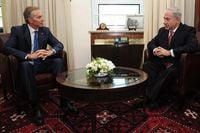In the battered, dust-laden ruins of Gaza, a new and highly controversial plan has emerged, promising an end to nearly two years of relentless warfare and devastation. At the heart of this proposal stands former British Prime Minister Tony Blair, who, according to recent reports from The Economist, AFP, and The New York Times, is being considered to lead a five-year international transitional authority over the Gaza Strip. The plan, known as the Gaza International Transitional Authority (GITA), would see Blair chairing a board with sweeping political and legal control, backed by the United Nations and Gulf states, before eventually ceding power to a reformed Palestinian government.
This ambitious scheme, which has reportedly won the blessing of U.S. President Donald Trump, comes amid a flurry of diplomatic activity as world leaders scramble to shape Gaza’s future. President Trump, sounding unusually optimistic, told reporters on Friday, “It’s looking like we have a deal on Gaza,” expressing confidence that the plan “will get the hostages back” and “will end the war,” as reported by The New York Times. But beneath the surface, the proposal faces a daunting array of challenges, not least of which is fierce opposition from Israeli Prime Minister Benjamin Netanyahu and deep skepticism among Palestinians weary of foreign intervention.
The structure of the proposed authority is, on paper, formidable. As detailed by The Economist and AFP, the GITA would become Gaza’s “supreme political and legal authority” for five years under a UN mandate. Blair would chair a seven-person board overseeing an executive body, supported by a secretariat of up to 25 people, with Gulf states footing the bill. The authority would initially set up shop in el-Arish, Egypt, just across Gaza’s southern border, only moving into the strip once stability is restored. Security would be managed by a multinational force, and the plan includes provisions for “protected departure certificates” to guarantee Gazans who wish to leave can return—an echo of historical anxieties about displacement.
Backing for the plan has come from powerful quarters. Jared Kushner, Trump’s influential son-in-law, and U.S. Middle East envoy Steve Witkoff have reportedly been instrumental in pushing the proposal in Washington. At a pivotal meeting on August 27, Blair, Kushner, and Witkoff made their case to President Trump, with Israeli Prime Minister Netanyahu’s close ally, Ron Dermer, joining by phone, according to The Economist. Days later, Trump presented the idea to leaders from Turkey, Pakistan, Indonesia, and five Arab states, declaring, “Maybe we can end it [the Gaza war] right now.”
But for all the international momentum, the plan faces a wall of resistance in Israel. Netanyahu, who recently addressed a largely empty hall at the United Nations after a mass diplomatic walkout, remains defiant. “The final remnants of Hamas are holed up in Gaza City,” he said, vowing, “Israel must finish the job.” He has condemned the recent recognition of a Palestinian state by Britain, France, Canada, and Australia as “sheer madness,” and has made clear his opposition to involving the Palestinian Authority, which he disparaged as “corrupt to the core,” according to The New York Times. Within his own coalition, hardline ministers have even more radical ambitions. Finance Minister Bezalel Smotrich has reportedly spoken of a “real-estate bonanza” in a depopulated Gaza, highlighting the ideological gulf that any international plan must bridge.
President Trump, meanwhile, has drawn a red line on Israeli ambitions, telling reporters he will not “allow” Israel to annex the West Bank—a goal cherished by the Israeli far right. “There’s been enough. It’s time to stop now,” Trump said, signaling a rare point of friction between Washington and Jerusalem. Some analysts, like George Washington University’s Ned Lazarus, believe that “Trump is probably the only one who can force Netanyahu off the course that he’s chosen,” as quoted by The New York Times. Yet, with Netanyahu warning that Israeli isolation is “inevitable” and urging the country to become economically and militarily “autarkic,” the odds of a breakthrough remain uncertain.
On the Palestinian side, reactions are equally complex. While surveys conducted by Blair’s team in May suggest that more than a quarter of Gazans might support some form of international rule, many remain deeply skeptical—especially of Blair himself. His legacy in the region is indelibly marked by his support for the 2003 U.S.-led invasion of Iraq, a decision later condemned by an official UK inquiry for relying on flawed intelligence. During Blair’s eight years as the Quartet’s Middle East envoy, Israel launched four major assaults on Gaza and tightened its grip on the Palestinian territories, fueling doubts about his ability to deliver real change.
“The Blair plan could be another occupation,” warned an adviser to Palestinian Authority President Mahmoud Abbas, speaking to The Economist. Fears abound that a temporary mandate could become a semi-permanent arrangement, reminiscent of the British mandate in Palestine that lasted three decades. The Palestinian Authority itself, which enjoys the backing of key Arab states, has little appetite for challengers. Abbas’s government has even jailed a businessman who floated the idea of governing Gaza, underscoring the fierce competition for legitimacy.
Hamas, for its part, has signaled a limited willingness to compromise. According to sources cited by The Economist, Hamas might consider handing over its weapons and allowing a technocratic government to run Gaza, but is unlikely to accept a plan that excludes its members from essential services like education and health. The Israeli government, meanwhile, insists that any deal must result in the complete destruction of Hamas as a political and military force—a demand that has repeatedly torpedoed previous ceasefire efforts, most recently in November 2023 and January 2025.
Despite the formidable obstacles, some figures in the Israeli security establishment appear open to the idea. Former Mossad chief Yossi Cohen told BBC Radio, in comments carried by AFP, “I love” the plan, calling Blair a “wonderful person” capable of shouldering the “huge” responsibility. The detailed proposal, a version of which was reviewed by The New York Times, even outlines contingencies for a multinational security force to conduct targeted raids against resurgent armed groups, aiming to prevent the re-emergence of chaos.
Yet, as the diplomatic drama unfolds, the fate of Gaza remains suspended between hope and hard reality. Blair, whose legacy is defined by sweeping constitutional reform at home and the controversial Iraq War abroad, is betting that a bold new role in Gaza could help right old wrongs. For Netanyahu, the calculus is even starker: accept a plan that might end the war and secure the return of hostages, at the risk of his coalition and political future—or continue on a path of isolation and conflict.
For the people of Gaza, weary from years of suffering and destruction, the prospect of yet another foreign-run authority brings both a glimmer of relief and a shadow of doubt. As history has shown, the road to peace in the Middle East is strewn with broken promises and missed opportunities. Whether this latest plan marks a genuine turning point or simply another chapter in a long-running tragedy will depend not just on the ambitions of leaders, but on the willingness of all sides to make painful compromises. The world, for now, watches and waits.



